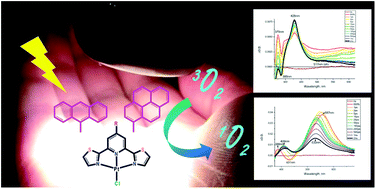Towards better understanding of the photophysics of platinum(ii) coordination compounds with anthracene- and pyrene-substituted 2,6-bis(thiazol-2-yl)pyridines†
Abstract
The photophysical properties of platinum(II) compounds with 4-(9-anthryl)-2,6-bis(thiazol-2-yl)pyridine (1) and 4-(1-pyrenyl)-2,6-bis(thiazol-2-yl)pyridine (2) were widely investigated. In DMSO and MeCN, the triplet emission of (1) and (2) most probably experiences the solvent-induced exciplex quenching and both complexes exhibit ligand-based fluorescence with maxima in the range of 468–570 nm. In non-coordinating dichloromethane, the emission of (1) and (2) shifts to longer wavelengths, and the lifetimes in microseconds are indicative of phosphorescence. The formation of the triplet excited state was further supported by the observation of singlet oxygen photoluminescence in the near-IR at 1270 nm. To explore the nature of the triplet excited state, the emission properties of (1) and (2) in low temperature glasses were analysed in comparison with those for free ligands and appropriate hydrocarbons, as well as transient absorption spectra were recorded in femtosecond and nanosecond regimes. The studies revealed that the lowest energy triplet state of both complexes is an admixture of 3ILCT and 3(π–π*)aryl character, but the contribution of the 3ILCT state in (1) originating from anthracene to 2,6-bis(thiazol-2-yl)pyridine can be determined as rather negligible.



 Please wait while we load your content...
Please wait while we load your content...